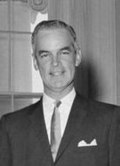| |||||||||||||||||
| |||||||||||||||||
 County results Welsh: 50–60% 60–70% Parker: 40–50% 50–60% 60–70% | |||||||||||||||||
| |||||||||||||||||
| Elections in Indiana |
|---|
 |
The 1960 Indiana gubernatorial election was held on November 8, 1960. Democratic nominee Matthew E. Welsh defeated Republican nominee Crawford F. Parker with 50.39% of the vote.

